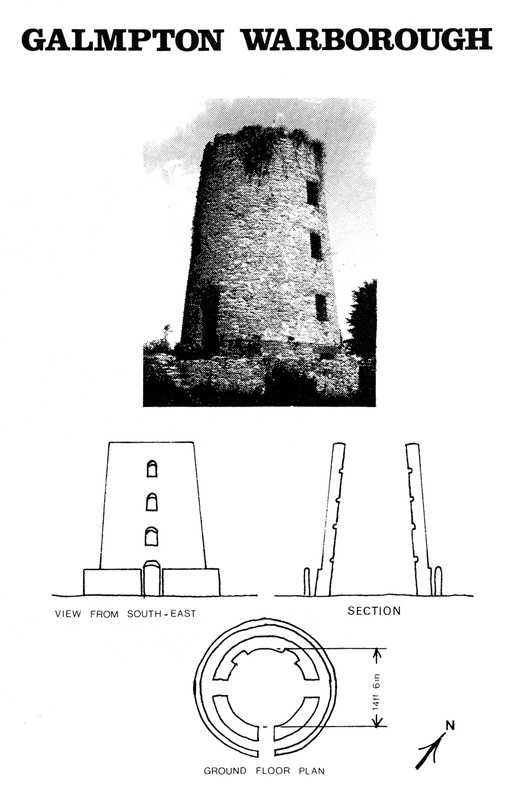Post by Dave on Sept 23, 2018 12:58:56 GMT
Warborough Common & The Windmill 23rd September 2018
Most of us have been stuck in a traffic jam heading towards Windy Corner from Brixham. As we slowly passed Churston Common we may have noticed a set of old goal posts and also the remains of an old windmill. In recent years in might have been an invasion by travellers that made us look at the common, or the state of the common after they were finally moved off it.
To many the common just looks like a large empty space with large stones around it to try and prevent and future travellers gaining access to it, but the common has an interesting history that many locals may not be aware about.
Is it Warborough Common or Churston Common? The name Warborough has Saxon origins and the common was a place they would gather to ward off and possible Viking invasions. In 1588 Sir John Gilbert of Greenway, Deputy-Lieutenant of the County of Devon, gathered together a militia force of over 1000 men on the common , in readiness to repel a Spanish landing.
It was during the Napoleonic Wars the windmill was built adjacent to the common, this was due to the need to increase quantities of flour. It is believed to have been built in 1810 and was in use in the early part of the nineteenth century. It ceased operating after a fire and then over the years fell into even more disrepair.
Back in 2003 the listed stone windmill tower became a subject of a planning application. The plans were for a modern themed conversion, with a part glazed viewing turret and a decked balcony at first floor level. There was very strong opposition to the plans by the locals as it was felt such changes would see the loss of the historical value of the old windmill. I can only imagine the plans were never accepted as the conversion never went ahead.
The common was also used as a military depot for the American army during the build up to the D Day invasion. Materials were stockpiled there before embarkation and the destination of Utah Beach, Normandy.
It has also been claimed that there was once a hangman's cross on the common. Many years ago one of the utility companies were digging down near Windy Corner to lay a pipe and found some bones. It is claimed the bones belonged to a smuggler as a thumb bone was missing. Back then men who were found guilty of stealing often had a thumb removed as a punishment. The location of the hangman’s cross in such a high and prominent position, also acted as warning to other criminally minded individuals.
The Squires of Galmpton, resident at Greenway had for generations held the jurisdiction of the common, but that changed in the 1930’s when the Warborough was given to the local community by the Williams family but very stick conditions were put on the use of the common.
Back then Totnes Rural District Council become the trustees of the common, but later due to boundary changes, Torbay Council became the trustees and the commoner’s rights included grazing and mowing the grass for hay were meant to be upheld.
It did not take Torbay Council very long to ignore the conditions that were in force on the common and just acted as if they actually owned the common. As a result in peak summer times in the 1970’s more than 400 cars were often parked on the common with ice cream vans having to pay Torbay Council to trade there.
Thankfully a lady by the name of Kay Sutton Coulson fought a seven or eight year long successful legal battle to keep the Galmpton Warborough common as an open common and one we all enjoy today.
As expected our wonderful local council took no notice of the many repeated protests and after discovering the Mrs Willaims was still alive and living at Caerhays Castle, in Cornwall, Kay Sutton Coulson sought her help. The council were aware they had no legal defence, but did nothing hoping she would just give up. In the end she took the matter to the high court and won and since then the council has behaved itself as far as ensuring Mrs Willams conditions are stuck too.
As a result we now have a beautiful open common free of all obstruction ( except for when the travellers get on it) for all to use for recreation, play, picnics and taking in the wonderful views across Torbay
It is also interesting to note that the ancient manor of Galmpton was first recorded in the Domesday Book as ‘Galmetona’, the name deriving from the Saxon ‘Gafolsman’, meaning a community of rent-paying peasants. Hardly the case now in Galmpton which many might see as an area that many well off people now live.
I had to wait until late morning for the drizzle to end and the sun come out before I set off to do today's photo shoot. The common is certainly bigger when you walk around it than you might think just driving past it. The last time I took any pictures of the windmill was back in 2011 and since then a window has been added to it at the top.
I wonder who owns the windmill and if there are any plans to ever add any sails to it as if that were to happen it would look wonderful. In Holland much was done to restore and preserve some of their old windmills, its a pity we do not do the same.
BELOW: Painting by George Bedford (1850 - 1920)
Sheep grazing on the common and the River Dart can be seen in the distance!
Courtesy of Torre Abbey Museum, Torquay































